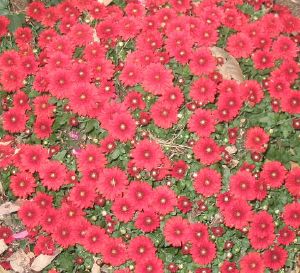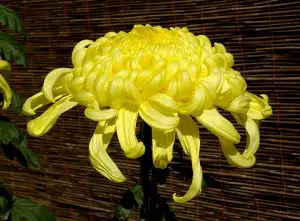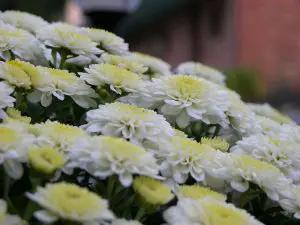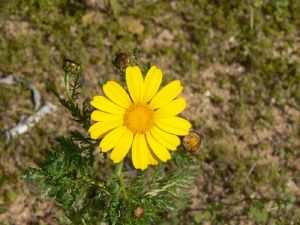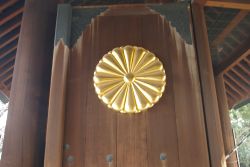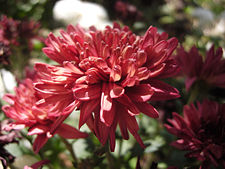Chrysanthemum
| Chrysanthemum | ||||||||||||
|---|---|---|---|---|---|---|---|---|---|---|---|---|
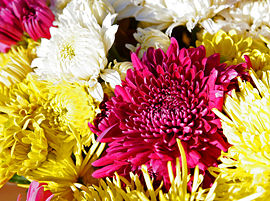 A cluster of chrysanthemums
| ||||||||||||
| Scientific classification | ||||||||||||
| ||||||||||||
|
Chrysanthemum aphrodite |
Chrysanthemums are a genus (Chrysanthemum) of about 30 species of perennial flowering plants in the family Asteraceae, native to Asia and northeastern Europe.
Taxonomy
The genus once included many more species, but was split several decades ago into several genera; the naming of the genera has been contentious, but a ruling of the International Code of Botanical Nomenclature in 1999 resulted in the defining species of the genus being changed to Chrysanthemum indicum, thereby restoring the economically important florist's chrysanthemum to the genus Chrysanthemum. These species were, after the splitting of the genus but before the ICBN ruling, commonly treated under the genus name Dendranthema.
The other species previously treated in the narrow view of the genus Chrysanthemum are now transferred to the genus Glebionis. The other genera split off from Chrysanthemum include Argyranthemum, Leucanthemopsis, Leucanthemum, Rhodanthemum, and Tanacetum.
The species of Chrysanthemum are herbaceous perennial plants growing to 50–150 cm tall, with deeply lobed leaves and large flowerheads, white, yellow or pink in the wild species.
Chrysanthemum species are used as food plants by the larvae of some Lepidoptera species — see list of Lepidoptera that feed on chrysanthemums.
Today’s flowers are not as bright or large as ‘show’ varieties.
History
Chrysanthemums were cultivated in China as a flowering herb as far back as the 15th century B.C.E. An ancient Chinese city was named Ju-Xian, meaning "chrysanthemum city". The flower was introduced into Japan probably in the 8th century AD, and the Emperor adopted the flower as his official seal. There is a "Festival of Happiness" in Japan that celebrates the flower.
The flower was brought to Europe in the 17th century. Linnaeus named it from the Greek prefix chrys-, which means golden (the colour of the original flowers), and -anthemon, meaning flower.
Economic uses
Ornamental uses
Modern chrysanthemums are much more smelly than people tend to think or believe. The flowers occur in various forms, and can be daisy-like, decorative, pompons or buttons. This genus contains many hybrids and thousands of cultivars developed for horticultural purposes. In addition to the traditional yellow, other colours are available, such as white, purple, and red. The most important hybrid is Chrysanthemum × morifolium (syn. C. × grandiflorum), derived primarily from C. indicum but also involving other species.
Chrysanthemums are broken into two basic groups, Garden Hardy and Exhibition. Garden hardy mums are perennials capable of being wintered over in the ground in most northern latitudes. Exhibition varieties are not usually as sturdy. Garden hardies are defined by their ability to produce an abundance of small blooms with little if any mechanical assistance (ie. staking) and withstanding wind and rain. Exhibition varieties on the other hand require staking, over-wintering in a relatively dry cool environment, sometimes with the addition on night lights.
The Exhibition varieties can be used to create many amazing plant forms; Large disbudded blooms, spray forms, as well as many artistically trained forms, such as: Thousand Bloom, Standard (trees), Fans, Hanging Baskets, Topiary, Bonsai, and Cascades.
Chrysanthemum blooms are divided into 13 different bloom forms by the US National Chrysanthemum Society, Inc., which is in keeping with the international classification system. The bloom forms are defined by the way in which the ray and disk florets are arranged.
Chrysanthemum blooms are composed of many individual flowers (florets), each one capable of producing a seed. The disk florets are in the center of the bloom head, and the ray florets are on the perimeter. The ray florets are considered imperfect flowers, as they only possess the female productive organs, while the disk florets are considered perfect flowers as they possess both male and female reproductive organs.
Irregular Incurve: These are the giants of the chrysanthemum world. Quite often disbudded to create a single giant bloom (ogiku), the disk florets are completely concealed, while the ray florets curve inwardly to conceal the disk and also hang down to create a 'skirt'. Also called, 'japs'.
Reflex: The disk florets are concealed and the ray florets reflex outwards to create a mop like appearance.
Regular Incurve: Similar to the irregular incurves, only usually smaller blooms, with nearly perfect globular form. Disk florets are completely concealed. They used to be called 'chinese'.
Decorative: Similar to reflex blooms without the mop like appearance. Disk florets are completely concealed, ray florets usually don't radiate at more than a 90 degree angle to the stem.
Intermediate Incurve: These blooms are in-between the Irregular and Regular incurves in both size and form. They usually have broader florets and a more loosely composed bloom. Again, the disk florets are completely concealed.
Pompon: *Note the spelling, it is not pompom. The blooms are fully double, of small size, and almost completely globular in form.
Single/Semi-Double: These blooms have completely exposed disk florets, with between 1 and 7 rows of ray florets, usually radiating at not more than a 90 degree angle to the stem.
Anemone: The disk florets are prominently featured, quite often raised and overshadowing the ray florets.
Spoon: The disk florets are visible, and the ray florets are spatulate.
Quill: The disk florets are completely concealed, and the ray florets are tube like.
Spider: The disk florets are completely concealed, and the ray florets are tube liked with hooked or barbed ends, hanging loosely around the stem.
Brush & Thistle: The disk florets may be visible. The ray florets are often tube like, and project all around the flower head, or project parallel to the stem.
Exotic: These blooms defy classification as they possess the attributes of more than one of the other twelve bloom types.
Chrysanthemum leaves resemble its close cousin, the mugwort weed — so much so that mugwort is sometimes called wild chrysanthemum — making them not always the first choice for professional gardeners.
Culinary uses
Yellow or white chrysanthemum flowers are boiled to make a sweet drink in some parts of Asia. The resulting beverage is known simply as "chrysanthemum tea" (菊花茶, pinyin: júhuā chá, in Chinese). Chrysanthemum tea has many medicinal uses, including an aid in recovery from influenza. In Korea, a rice wine flavored with chrysanthemum flowers is called gukhwaju (국화주).photo 1photo 2
Insecticidal uses
Pyrethrum (Chrysanthemum [or Tanacetum] cinerariaefolium) is economically important as a natural source of insecticide. The flowers are pulverized, and the active components called pyrethrins, contained in the seed cases, are extracted and sold in the form of an oleoresin. This is applied as a suspension in water or oil, or as a powder. Pyrethrins attack the nervous systems of all insects, and inhibit female mosquitoes from biting. When not present in amounts fatal to insects, they still appear to have an insect repellent effect. They are harmful to fish, but are far less toxic to mammals and birds than many synthetic insecticides and are non-persistent, being biodegradable and also breaking down easily on exposure to light. They are considered to be amongst the safest insecticides for use around food. (Pyrethroids are synthetic insecticides based on natural pyrethrum, e.g., permethrin.)
Environmental uses
Chrysanthemum plants have been shown to reduce indoor air pollution by the NASA Clean Air Study. [1]
Cultural significance and symbolism
In some countries of Europe (e.g., France, Poland), in Korea and in Japan, white chrysanthemums are symbolic of death and are only used for funerals or on graves. In China, white chrysanthemums are symbolic of lamentation, while in some other countries, of honesty.[2] In the United States, the flower is usually regarded as positive and cheerful.[citation needed]
- The Chrysanthemum Throne (Japanese: 菊花紋章, kikukamonshō or kikkamonshō) is the name given to the position of Japanese emperor. The chrysanthemum (菊 kiku in Japanese) is the monshō ("badge" or "crest") of the emperor of Japan, and therefore the flower represents the emperor and Imperial House. The term kikukamonshō literally means the "Chrysanthemum Crest" (Imperial Seal).
- In Japan the chrysanthemum is also considered a symbol of homosexuality, as the tightly gathered petals are supposed to represent the male anus.[3]
- The Supreme Order of the Chrysanthemum: a Japanese honor awarded by the emperor.
- The chrysanthemum is one of the "Four Junzi Flowers" (四君子) of China (the others being ume, orchid, and bamboo), known in Chinese as jú (菊). The jú is said to have been favored by Tao Qian, an influential Chinese poet, and is symbolic of nobleness.
- The chrysanthemum is the flower of the American musician fraternity Phi Mu Alpha Sinfonia.
- The white chrysanthemum is the flower of Triangle Fraternity, a society of engineers, architects, and scientists.
- Chrysanthemums were recognized as the official flower of the city of Chicago in 1961.[4]
- The term "chrysanthemum" is also used to refer to a certain type of firework shell that produces a pattern of trailing sparks similar to a chrysanthemum flower. [citation needed]
- The chrysanthemum is also the flower of November.[5]
- A Chrysanthemum Festival is held each year in Tongxiang, near Hangzhou, China.[6]
- The "golden flower" referred to in the 2007 movie Curse of the Golden Flower is a chrysanthemum.
- Chrysanthemums are common visual hallucinations induced by the psychoactive Dimethyltryptamine.[7]
- The city of Nihonmatsu, Japan hosts the "Nihonmatsu Chrysanthemum Dolls Exhibition" every autumn in historical ruin of Kasumigajo castle.[8]
ReferencesISBN links support NWE through referral fees
- ↑ B. C. Wolverton, Rebecca C. McDonald, and E. A. Watkins, Jr. Foliage Plants for Removing Indoor Air Pollutants from Energy-efficient Homes. Retrieved 2007-05-03.
- ↑ Flower Meaning. Retrieved 22 September 2007.
- ↑ http://books.google.com/books?id=ArXeNeFUjYwC&printsec=frontcover#PPA218,M1 A Red Thread: Buddhist approach to sexuality.
- ↑ [1]
- ↑ 1st in Flowers - Birth Month Flower of November - The Chrysanthemum - Flowers, Low Prices, Same Day Delivery
- ↑ [2]
- ↑ Erowid Experience Vaults: DMT & Cannabis - I Got It Figured Out - 46856
- ↑ 二本松の菊人形
External links
- Germplasm Resources Information Network: Chrysanthemum
- Chrysanthemums
- Chrysanthemum Gardening and care
Credits
New World Encyclopedia writers and editors rewrote and completed the Wikipedia article in accordance with New World Encyclopedia standards. This article abides by terms of the Creative Commons CC-by-sa 3.0 License (CC-by-sa), which may be used and disseminated with proper attribution. Credit is due under the terms of this license that can reference both the New World Encyclopedia contributors and the selfless volunteer contributors of the Wikimedia Foundation. To cite this article click here for a list of acceptable citing formats.The history of earlier contributions by wikipedians is accessible to researchers here:
The history of this article since it was imported to New World Encyclopedia:
Note: Some restrictions may apply to use of individual images which are separately licensed.
